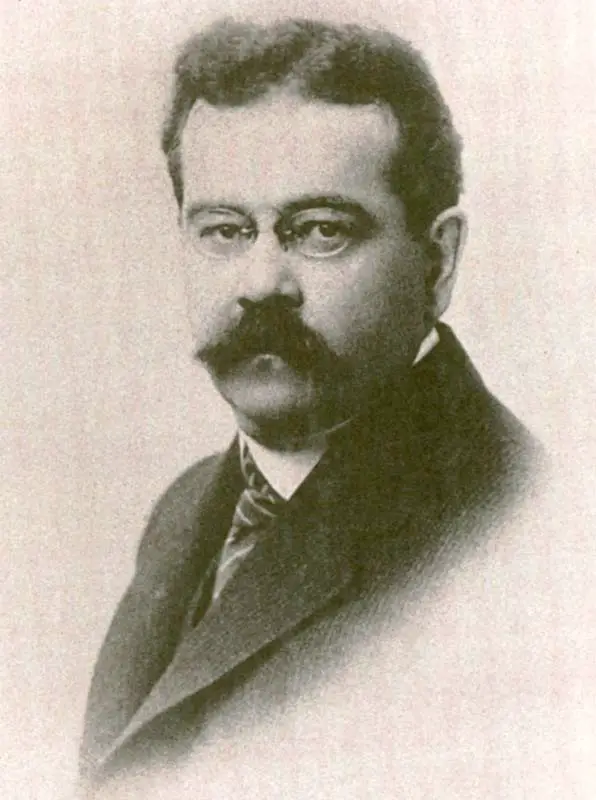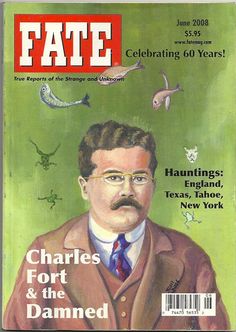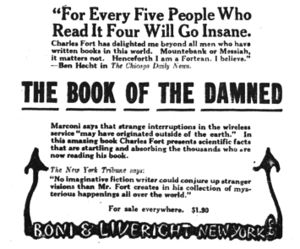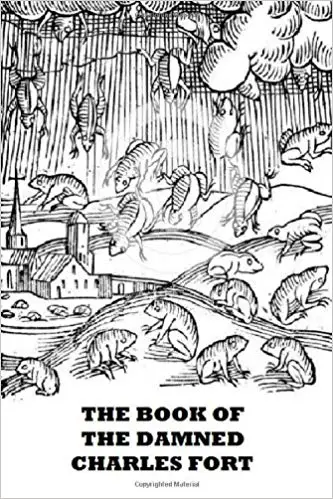Critic of science that he defined as "exclusionist", that is, inclined to accept only data that confirmed accepted theories and reject data that cast doubt on them, Charles Fort proceeded, in the manner of the ancient collators of "wonders", to collect and analyze all the so-called anomalies, those "damned facts" that had no place in scientific models, influencing to a certain extent the whole sphere of the "alternative reality" of the twentieth century, such as ufology, space archeology and cryptozoology.
di Francesco Cerofolini
We live in a much stranger and crazier universe than we think. Charles Hoy Fort was convinced of this and to prove it he spent most of his adult life in the archives of libraries and museums hunting for reports of events that science could not explain. Supported only by his wife and a small group of admirers, Fort accumulated nearly forty thousand notes in his home turned archive. In this huge amount of papers there was everything: rains of fish, coal, sulfur. Abnormal aerial phenomena. Mysterious appearances and disappearances. People with exceptional faculties. And the list could go on and on.
From this substantial documentation Charles Fort drew four books, The Book of the Damned, The!, New Lands e Wild Talents, with whom he wanted to submit these uncomfortable data to the science of the time, a Science that Fort considered no less dogmatic than the religions of the past. This massive offensive to the citadel of science proved in vain and upon his death Fort was, beyond a few narrow circles, virtually unknown. However, his work and his ideas were received by artists and thinkers who rediscovered his work especially after World War II.
Today many of Fort's ideas permeate popular culture, just think of the term 'teleportation' coined by Fort. Retracing the human story and rediscovering its provocative thought, we understand how Fort was not only a compulsive collector of oddities: his work was also an act of rebellion against a society which, behind the patina of progress, was conformist and dehumanizing and which also aimed to regulate the very perception of reality.

The Bronx Writer
In 1887 the chemist Marcelin Berthelot wrote that "from now on there is no longer any mystery in the Universe». In 1895 the famous physicist Lipmann ruled that physics was an exhausted field of research. Really Heinrich Hertz he considered the radio wave research he discovered to be of no practical use. These statements are indicative of the cultural climate that reigned between the nineteenth and twentieth centuries: science would soon explain everything, nature had been tamed and man was heading towards a future of peace and prosperity. In this particular intellectual landscape Charles Fort grew up.
Charles Fort was born in Albany on August 6, 1874, second son of a wealthy merchant. His mother died when Charles was still small. His father, a severe and authoritarian man, subjected Charles and his brothers to an iron discipline. In his never published autobiography entitled many parts, Fort tells how he and his brothers were locked up in a closet as punishment, sometimes even for days. These experiences matured in Fort a distrust and hostility towards any kind of authority, an attitude that he will carry with him throughout his life.
Little Charles immediately showed a great interest in nature: he first began to collect shells and starfish and then the wings and eggs of birds that he himself hunted with a slingshot. He was a mediocre and undisciplined student, but at home he devoured books on everything from geography to foreign languages, from natural history to biology. During his teens, Fort discovered that he had a talent for writing and so he decided that he would become a writer. At eighteen he embarked on a solo trip around the world. Fort hoped that knowing different places and people he would accumulate material to write about. For nearly two years he wandered between Europe, America and Africa supporting themselves only with occasional jobs and with the little money sent from home. His adventures ended in South Africa where he contracted malaria and was forced to return to the United States.
In 1896 he married Anna Filing. The couple settled in New York, where they lived in severe poverty in the Bronx for several years. During these years Fort moved from one occupation to another as he attempted to get his writing career off the ground. During the colder months the couple were forced to burn old furniture to keep warm and on rainy days Fort was unable to go out to look for work because his shoes were punctured. Fort during that time is often prey to depression and suicidal thoughts. However, persevering, he managed to sell some of his humorous stories to some magazines.
The great novelist Theodore Dresier defined the Fort tales as "the best humorous stories produced in America […] were realistic, ironic, wise and in their own way beautiful». Encouraged by these small successes, Fort decided to devote himself to writing novels. Of the many novels that he seems to have written, only the only one published - that is The Outcast Manufacturers — survived. Like his stories, this novel was also set in the poor and proletarian neighborhoods where Fort lived, and followed the stories of a couple of swindlers. The novel was warmly received by critics but proved to be a commercial failure.

The procession of the damned
In the period between 1910 and 1918, Fort's disillusionment with science and academia reached its zenith. Fort was a voracious reader and kept thousands of notes on a variety of subjects. He decided to burn the over twenty-five thousand notes to make room for an even more substantial archive in which to keep and cataloging all the events that conventional science not only could not explain but which it even refused to consider. Over the years, this new archive will count - as mentioned - over forty thousand notes.
The constant search for strange and mysterious facts became, in Fort's words, a real obsession that led him to search the archives of libraries over and over again. His house will become a bizarre cross between an archive and a museum. The modest apartment in which Fort lived was full of filing cabinets in which the writer kept the fruit of his research, of collections of spiders, butterflies and insects, of samples of mysterious substances that it is said they had rained down from the sky and from years to years of scientific journals. Fort, who now collected impossible facts with the same meticulousness with which he collected insects and shells in his childhood, had the intuition that will mark his life forever: the way to knowledge passes through the study of anomalies.
During this period Fort wrote two books, respectively titled X e Y. The manuscripts of the books were burned by Fort after yet another rejection by a publisher. From the letters that Fort sent from his friend Dresier we learn that X he explored the hypothesis that events on Earth were influenced by invisible means by the inhabitants of Mars. Dresier thus relates some of the hypotheses that Fort had expounded in the manuscript: "X was the mysterious something from which these rays emanated. [...] These rays were the emanation of something that was capable of using them as a means of creating us, you, me, all the animals, plants, the earth in all its beauty, variety and strangeness". Fort compared the action of these rays on earth to that of light imprinting an image on photographic film.
Y instead it was about another civilization, this time located at the South Pole, which had been conspiring against humanity since time immemorial. In book even speculated that Kaspar Hauser was an emissary of this phantom civilization. This hectic period was marked by refusals by publishers, burning of notes and manuscripts, feverish searches and continuous rewrites that culminated in the book that will give Fort fame, that is The Book of the Damned. Fort's work too would certainly have been destined to follow the sad fate of his predecessors had it not been for the intercession of his novelist friend. Theodore Dresier, who literally blackmailed his publisher, threatening him to leave the publishing house if he didn't get Fort's work to print. Published in 1919 The Book of the Damned it immediately became a publishing case and although the modest sales did not solve Fort's precarious economic situation, the book guaranteed him a small but loyal following of admirers.
The Book of the Damned it is a labyrinthine work, a mixture of bizarre and mysterious facts that become the starting point for dizzying cosmological speculations and daring theorizing on science and knowledge. Fort is only the latest author to try his hand at the collection of wonders, a tradition that follows from the Latin historian Giulio Obsequente and from his Book of Prodigies, passing through the medieval bestiaries and works like il Book of Wonders di Gervasio of Tilbury, but Fort deals with the marvelous and the bewildering with the skeptical and iconoclastic air of his time.
Even if over the years Fort has been portrayed as a credulous or worse still a charlatan, reading him free from prejudices it is clear how this author puts into practice a radical skepticism, for which even the most absurd facts and the most imaginative speculations are worthy of a ' accurate analysis. The science fiction writer Damon Knight, author of the biography Charles Fort, Prophet of the Unexplained, thus summarizes Fort's attitude towards scientific investigation:
" IS a cliché that adolescent writers would be lonely and rebellious. Fort, having denied paternal authority harder than normal - or having been denied by it - he seemed to be determined to question all authority, and ultimately deny it. "
This combination of intellectual curiosity and existential rebellion led him to take sides in everything that official science considered heretical. Also according to Knight, he "became the defender, not of his eccentric hypotheses, but of the discarded data themselves. It was not contrary to science, or to the scientific method, but to the closed system of science, or to the elevation of the hypothesis to dogma.". These discarded data are the "damned" who give the book its title. With his usual imaginative style, Fort opens his work as follows:
« By the word damned, I mean the excluded.
We will then have a parade of data that Science has ruled out. Battalions of the damned, led by diaphanous data that I have exhumed, will set out. You will read them ... that is, they will march. Some of them are bruised, others flaming, still others rotten.
Some of them are skeletal corpses, writhing, tottering mummies, animated by comrades who have been damned while alive. There are giants who will pass by, but will be sound asleep. There are things that are theorems and others that are just rags: they will parade under Euclid's arm with the spirit of anarchy. Here and there will be some sluts. Many are fools but many are of the utmost respectability. Some are murderers. There are faint stenches and meager superstitions, simple shadows and lively mischief: whims and amiability. The naive and the pedantic, the bizarre and the grotesque, the sincere and the insincere, the profound and the childish. [...] The power that said all these things are of the damned is Dogmatic Science. »

Adrift in the Super Sargasso Sea
In the vast assortment of unexplained events documented by Fort they occupy a prominent place anomalous precipitations. During his research, Fort had ascertained that not only rain and snow fall from the sky. Numerous reports speak of red rains, also called "rains of blood ". Il 12 and 13 November 1902 red rains hit Australia and the following year it was Europe's turn. February 27, 1903 a strange red substance rained down on Belgium, Holland, Germany and Austria. A ship sailing the Atlantic Ocean reported a similar phenomenon. In the same period, rains of red mud hit Russia and the United Kingdom. Digging backwards it turns out that the phenomenon is repeated identically in different places and times: in China in 1877, in Siena on December 28, 1860, in the Mediterranean in 1888… and the list goes on.
From time to time, scientists analyze the samples, some ascertaining that it is sand from the Sahara desert, others organic matter. Theories are formulated to explain the bewildering events. For example, a certain EG Clayton hypothesizes that the reddish rains over England are due to the "dust carried by the wind from the streets and lanes of the Wessex ". Fort with the sarcasm that distinguishes him he comments: "That is, every explanation is an explanation of Wessex: with this I try to interpret the enormous in terms of the minuscule».
The minds of the skeptics for Fort "they settle into the concept of a small world, isolated and comfortable, devoid of contact with cosmic evil, safe from stellar tricks, undisturbed by invasions and looting star». Fort instead starts from these facts to launch into wild and imaginative speculations, determined as much to provoke as to surprise the reader. "I personally think that in 1903 we passed through the remains of a pulverized world ... relic of an ancient interplanetary dispute and which had since remained in space as a red warning». In Fort's hypothesis, the Earth was like an island in the middle of the ocean towards which currents dragged the remains of planets and "provisions from supervessels that crashed in interplanetary traffic».
But even stranger things fall from the sky. Fort collected reports of precipitation of beef and butter-like substances, stone and iron, and even artifacts that fell from the sky in conjunction with violent storms. In this variegated casuistry the most disconcerting phenomena are certainly those that concern rains of animals: the best known are certainly those of frogs and toads such as those that fell from a dense cloud that suddenly appeared near Toulouse in 1804, as well as those of fish, documented since ancient times. Fort presents us with a large selection of these bizarre events: Mussel rain in Germany in 1892, rain of lizards in Canada in 1857, hundreds of snakes "appear" after a violent storm in 1877 in Memphis, Tennessee, ant rain in England in 1874.
Scientists dismissed the stories as rumors or exaggerated reports, others brought up the action of sea horns or tornadoes that "sucked in" the groups of animals and then deposited them in the place of precipitation. For Charles Fort these explanations were not enough and so he constructed one of his most visionary and far-fetched hypotheses. To explain these mysterious rains Fort postulated the existence of the Super Sargasso Sea, a region above the Earth's atmosphere where it ended - in his opinion - everything that was captured by mysterious cosmic forces and remained there in a sort of limbo even for years or centuries before being thrown back to Earth from the storms that occasionally troubled this sea. According to Fort, if we could have visited this sea we would have found:
“Wrecks, debris, old cargo from space shipwrecks; things projected into what is called the space of the convulsions of other planets, things from the times of the Alexandrians, the Caesars and Napoleons, Mars and Jupiter and Neptune; things sucked up by the cyclones of the earth: horses and stables and elephants and flies and dodi and moa and pterodactyls; all, however, which tend to disintegrate into homogeneous mud or sand, red or black or yellow ... authentic treasures for paleontologists and archaeologists ... centuries-old deposits ... the cyclones of Egypt, Greece, Assyria ... fish withered and stiffened, there for a short time; others long enough to putrefy. "
Fort in his "supergeographic" speculations (as he called the study of the "Super Sargasso Sea") went so far as to hypothesize a region similar to the Earth located in the Super Sargasso Sea, a planet called Genestrine on which primitive forms of life would have developed which, thanks to the storms of the said "sea", would have "rained" on the Earth and would have populated it.
Among the many oddities that fell from the sky, the most bizarre is certainly the one that Fort found reported in the September 10, 1910 issue of Scientific American magazine. Defined by Fort «one of the most cursed of our data», The article refers to «a strange stone resembling a meteorite, [which] fell in the Yaqui Valley, Mexico, and from one end of the country to the other went around the story that it had come down to earth a stone that bore inscriptions human». Fort reports of another aerolite with mysterious signs, which would have crashed near Brescia on February 16, 1883: this time the meteorite would bear the imprint of a human hand. Who was the sender of these strange messages?

Finds from Elsewhere
Strange things come from the sky and equally strange are the things that come to light by digging underground. Ample space is dedicated by Fort to extraordinary archaeological finds, which cast doubt on the history of the planet as we have known it. The catalog is also in this case wide and varied. A farmer from Cass County in Illinois finds a bronze coin bearing the ancient Greek inscription "King Antiochus Epiphanes the Victorious". Fort reports the discovery of a Roman coin in an Illinois mound. The more you delve into the pages that Fort dedicates to the topic, the more incredible the discoveries become:
“Stone tablets inscribed with the Ten Commandments in Hebrew are said to have been found in mounds in the United States. Masonic emblems are said to have been found in US mounds. "
In 1838 it was found in an ancient burial mound in Grave Creek in West Virginia "a small flat oval stone - or disc - on which alphabetic characters were engraved». These “out of place” finds both chronologically and geographically cast doubt on the history of the American continent. However, there are others that Fort, with his sagacity and imagination, uses to ask even more disturbing questions.
They were found in Virginia tiny crosses, weighing between 7 and 28 grams, no bigger than a pinhead. The geologists who analyzed them concluded that they were made of crystal and that they formed spontaneously. Fort was, of course, of a completely different opinion:
“A race of tiny beings. They crucified cockroaches. Exquisite beings ... but here is the cruelty of their delicacy. In their small size they were human beings. They crucified. "
Fort then goes on to list other accounts of findings of miniature tools such as the so-called pygmy flints. Pygmy flints «they are tiny prehistoric tools. Some of them are the size of a quarter of an inch (0,6 centimeters). England, India, France, South Africa - have been found in many parts of the world - whether or not they have been rained down there. areas». Who were these tiny beings? As with the mysterious rains, Fort finds the origin of the artifacts in the sky. The tiny beings would come to Earth from a hypothetical planet that Fort calls Elvera:
"[...] we think that the inhabitants of Elvera came here only for a visit: arrived in hordes as thick as clouds of bats for hunting trips ... of mice I would say [...] or more likely, to convert the pagans here ... [... ] They must have been missionaries. "
Their small and fragile bodies would not have been preserved as fossils but their artifacts would, and Fort quotes a July 20, 1836 London Times article reporting on discovered in a rock formation near Edinburgh by «a small cave. Seventeen tiny coffins. Three to four inches long. In the coffins there were wooden figures in miniature».
Other findings suggested that gigantic beings had walked the Earth in the distant past. Fort reports several findings made inside burial mounds of weapons and tools too large and heavy to be used by an ordinary human being. Even a report speaks of human footprints from 45 to 50 centimeters long that would have been found in the sandstone in Nevada. In the light of this news for Fort the legends about giants and "Little people" they acquired a new credibility.
These findings prompted Fort to consider the hypothesis that Earth had been visited in the past by beings from other worlds. Charles Fort was the first author to popularize this idea which will have great success both in the field of science fiction literature and in the field of pseudosciences and "alternative realities". Visits from aliens could explain the many misplaced artifacts, like Roman coins in America:
"We are of the opinion that there have been disasters in the air, and that coins have fallen down here and that the inhabitants of the earth have found them or seen them fall, and that they too minted the coins by imitation: it may be that the coins were dropped down here by some tutelary being who intended to advance us from the stage of bartering to the use of exchange. "
Charles Fort in his writings however overshadows a more disturbing scenario in which unsuspecting humanity is at the mercy of alien entities of which he ignores the existence and the plans they have in store for it:
«I would say that we belong to something: that this land was once a No Man's Land and that other worlds explored and colonized it and fought each other for possession, but that it is now possessed by something. That someone owns this land and everyone else has been advised to stay away. "
Fort suggests that to make our planet precious and attractive to our "masters" it would be us humans: we would be their cattle in a nutshell:
"I suspect that we are useful after all ... and that an agreement has been reached between the contending claimants, namely that now something has legal rights over us, obtained by force or by paying with the equivalent of our glass necklaces. to our first and most primitive owners - after having warned all the others to move away - and that all this had been known for centuries by certain inhabitants of the earth, by a sect or order, by members who act as pack leaders for us others, or who are super-slaves or controllers who direct us according to our instructions received… somewhere else… for our mysterious utility. "
Fort also believes he has found evidence of communications between these human groups and their unknown superiors. In one of his most daring imaginative flights, Fort states that footprints have been found in the rocks of various parts of the planet which he calls "shaped coffee cup»Arranged in rows. Fort sees similarities with the Braille alphabet and the Morse code and imagines that the signs are the result of a remote transmission that has imprinted them in the rock:
“Perhaps the forces behind the history of the earth have left writings on the rocks of Palestine, England, India and China, which will one day be deciphered, concerning instructions addressed to certain esoteric groups. "

Fort and Science
What to do with all this incredible data and the puzzling conclusions that Fort has come to? Surely not accept them uncritically, because it would be doing a disservice to Fort's work. On the other hand, it was he himself who wrote: "I don't believe anything I've written». Just as it is legitimate to have some doubts about the accuracy of the reports collected by Fort. Fort himself saw himself as a pioneer who collected all available data without worrying about its accuracy. Verification would have been work to be carried out at a later stage:
“I don't think I'm making an idol of the absurd. I think that in the first few attempts, there is no means of knowing what will be acceptable later on. If one of the pioneers of zoology (which is to be redone) hears of birds popping up from trees, he should report that he has heard of birds popping up. from the trees. Then he should take care, but only then, to examine the data of this fact. "
This brings us to the question of the relationship between Charles Fort and science. It was certainly a conflicting relationship. Il New York Times he defined it even "the enemy of science". An effective definition but not very accurate. If it is true that Fort did not skimp on even ferocious attacks on the science of his time, it is also true that he never completely rejected the scientific method. Fort was a skeptic, a critical skeptic of science whom he defined as an "exclusionist" or inclined to accept only data that confirmed accepted theories and reject data that cast doubt on them.
This trend led in his opinion to a deadly stagnation and prevented real scientific progress. Crucial for Fort was the analysis of anomalies, of those damned facts that had no place in scientific models. In confirmation of this Fort wrote not without irony:
“There is a lot in today's most accepted sciences that represents a rehabilitation of so-called legends, superstitions and folklore. Remember Voltaire's disbelief in the face of fossils, which according to him only the peasants could believe ... He was one of the sharpest minds, but he could not accept the data, because he refused the explanation for those data ... Today there are certain backlogs who don't believe in witches: but every married man knows the truth! "
For Fort, scientific progress passed from the study of data that questioned accepted models, rather than data that confirm them, thus favoring the emergence of new paradigms: "The science of today ... the superstition of tomorrow. The science of tomorrow ... the superstition of today». In certain parts of his writings, on the other hand, he seems to see the inadequacy of the science of his time as a salvific for man: fully in line with the Lovecraftian narrator of the phenomenal incipit de The Call of Cthulhu he judges that "Every science is a mutilated octopus. If its tentacles weren't cut into pieces, it would come into contact with disturbing things. ' In short, science exclusionist of his time was unable to understand man and his place in the universe and perhaps for the quiet life of humanity it was better this way.

The legacy of Charles Fort
Even if today the name of Charles Fort says nothing to the general public, his ideas have penetrated the collective imagination and have become the heritage of the modern folklore of "alternative realities". In this particular niche Fort has become a watershed, to the point of being considered the first "modern" scholar of the paranormal. To some extent all pseudoscientific disciplines such as ufology, space archeology and cryptozoology descend from the work of Fort and it is not hazardous to say that without his books this cultural trend would not be the same. The importance of him in this field is such that he was coined the term "fortiano" (fortean in English), with the double meaning of follower of Fort and typology of phenomenon (which could have been) studied by Fort in his works.
In the second half of the twentieth century, dozens of authors continued Fort's work or were influenced by it. The French Louis Pauwels e Jacques Bergier they cite Fort as one of the exponents of "magic realism" in the seminal The Morning of the Magicians. Among the most influential followers of Fort we must certainly remember the journalist and researcher John A. Keel, together with Jacques Vallee one of the greatest proponents of the "paraphysical" UFO hypothesis. Known above all for having made the legendary figure of the famous Mothman, Keel in his books continues the work of cataloging the absurd begun by Fort and tries to find a common thread that connects the most disparate types of anomalies.
Another field in which Fort's ideas have had great success was that of science fiction, specifically that sub-genre with uncertain borders that goes by the name of weird. Here too there are numerous examples of authors who drew on Fort's books for short stories and novels, but there is one author in particular with whom Fort shares his peculiar vision of the world, namely the aforementioned Howard Philips Lovecraft. Reading certain considerations on the universe, the dark forces that govern it and the "blissful ignorance" of the human being put on the page by Fort, the mind can only run to the best tales of the Providence loner.
Both of these men, lonely, obsessive and misanthropic, conceived the universe as a cold and hostile place at the mercy of blind and incomprehensible forces, in which the human being survived, fleeing the horror that comes from knowledge by shielding himself with the dogmas and fetishes of religions and sciences. The writer Lyon Sprague de Camp in his Lovecraft: A biography, tells how Lovecraft was enthusiastic about the The Book of the Damned, finding it a great source of inspiration for stories while not taking Fort's ideas seriously, so much so that he cites the New York writer in his story The one who whispered in the darkness. While it turns out that he has never met Fort, nor that the two have corresponded, however de Camp does not rule out that Lovecraft may have been introduced to Fort during the time he lived in New York.
The most successful outcome of the marriage between Fort's theories and science fiction fiction is certainly the novel Slaves of the Invisibles (in original Sinister Barrier) Of Eric Frank Russell, published in 1943. Taking a cue from the famous maxim of Fort «I think we are the property of others», The story tells of a group of scientists who discover that the earth is inhabited by aliens invisible to the naked eye, the Vitons. From the appearance of small spheres of energy, the Vitons feed on the nervous energies and suffering of unsuspecting humans and for this reason they have negatively affected human history from time immemorial. In this novel Russell develops many of Fort's ideas, also anticipating many of the ideas that will become very popular in the field of alternative realities in a few decades, such as the theme ofinfluence of parasitic entities throughout the history of humanity and that of alien abductions.
Despite the century that has passed since the publication of The Book of the Damned, Fort and his work remain relevant, and in some ways controversial. Over the years he has been called either a prophet or a charlatan: he certainly would not have accepted either definition. Fort was, as we said at the beginning, a strange kind of rebel; and, after all, they offer us the best synthesis of her figure Bergier and Pauwels of it The Morning of the Magicians:
«Before the first manifestations of Dadaism and Surrealism, Charles Fort introduced into science what Tzara, Breton and their disciples would have introduced into the arts and literature: the flamboyant refusal to play a game in which everyone cheats, the violent assertion that "there is more". An enormous effort, perhaps not to think of the real as a whole, but to prevent the real from being thought in a falsely coherent way. An essential break: "I am a gadfly who irritates the leather of knowledge to prevent it from sleeping." "

Bibliography:
- Charles Fort, The Book of the Damned
- Charles Fort, The Complete Books of Charles Fort
- Damon Knight, Charles Fort: Prophet of the Unexplained
- Louis Pauwels and Jacques Bergier, The Morning of the Magicians
- Lyon Sprague de Camp, Lovecraft: A biography

8 comments on “Charles Fort and the restlessness of the extraordinary"